

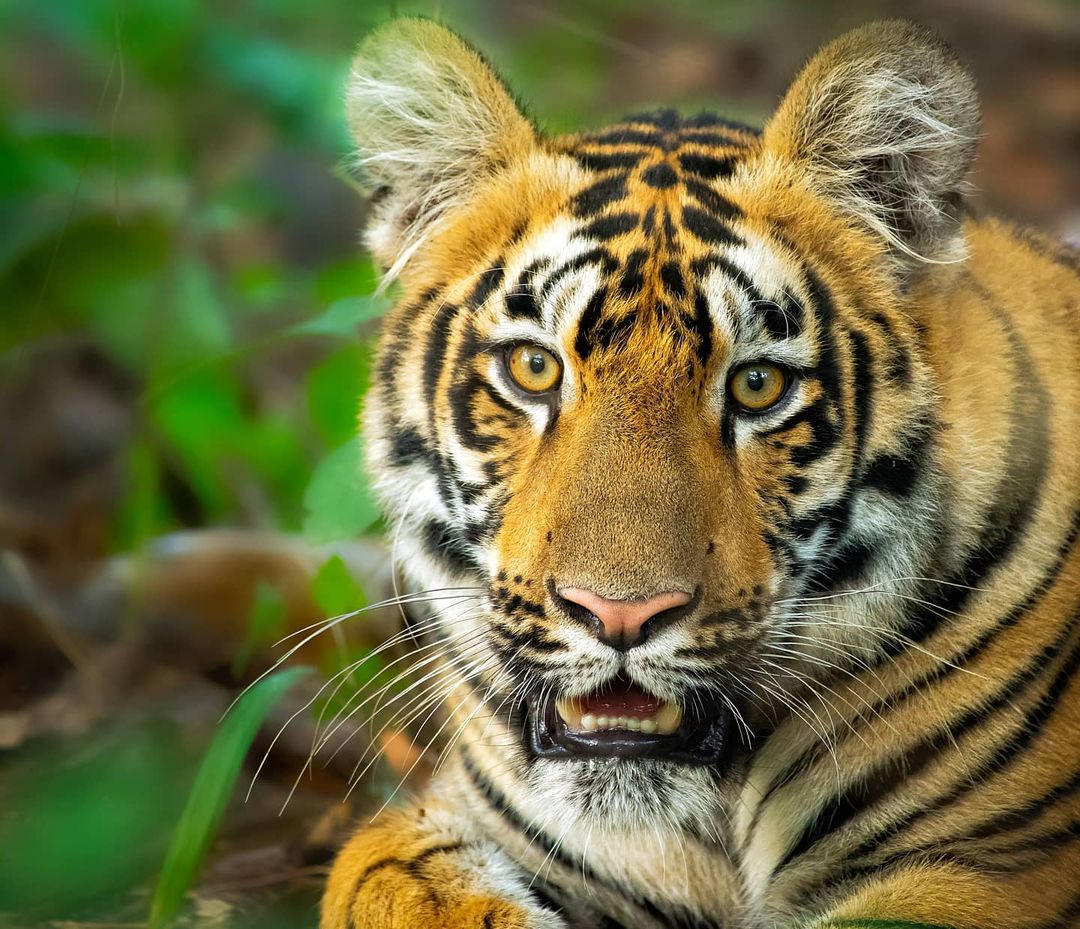 Tiger Cub_Tadoba National Park. 2020. Instagram. Courtesy of Nihad Vajid.
Tiger Cub_Tadoba National Park. 2020. Instagram. Courtesy of Nihad Vajid.
“Staring into the huge, cold yellow eyes of a tiger just a short distance away is an awesome experience, and Tadoba is where it can happen.” This is how Wild Images pitches one of its India-based photo tours to visitors on its website. Over on Instagram, wildlife photographers are routinely uploading the selfsame image of a Bengal tiger with “cold yellow eyes.” Telling one of the Internet’s most famous big cat photos apart from a sales pitch for a real-world experience in nature is difficult.
What’s easier to see is how Instagram’s tiger fills with ease an advertising spot for the “real thing” – the “awesome experience” promised by Wild Images, or any one of many commercial services based out of India’s national parks. On one side of this equation, both targeted and inadvertent social media marketing would seem to be doing a good job: multiplying tiger images on Instagram coincide with a sharp rise in customers paying to visit protected areas across India. The flipside of growing visitor numbers and expanded infrastructure for tiger tourism, though, are the hundreds of villages that have been relocated out of tiger reserve areas. According to Down to Earth, “A total 18,493 families in 215 villages across Protected Areas (PA) in India have been displaced in the 48 years since the inception of Project Tiger.” Oftentimes, tourism and conservation are seen in compatibility terms, while human settlements that could have endured for hundreds of years, without any negative environmental impact, are presented as threats to the tiger’s survival. Speaking from the perspective of political ecology, Nitin Rai – in an article titled “Inserting History and Politics in Conservation” – asserts, “It is time to rethink, revise, and reject the modern idea that people and wildlife have to be isolated and managed separately, scientifically, and by expert knowledge alone.” Rai’s viewpoint – that delinking human society from species-rich areas ignores a historical precedent of communities co-existing with animals in biodiverse ecosystems – is widely shared. This people-less wilderness emerges as an entity that, far from simply needing protection, requires construction in the first place. Instagram’s tiger photos that frame the animal in a seemingly undisturbed environment, expunging markers of human presence, encapsulate this drive to mythologize an idea of wild nature.
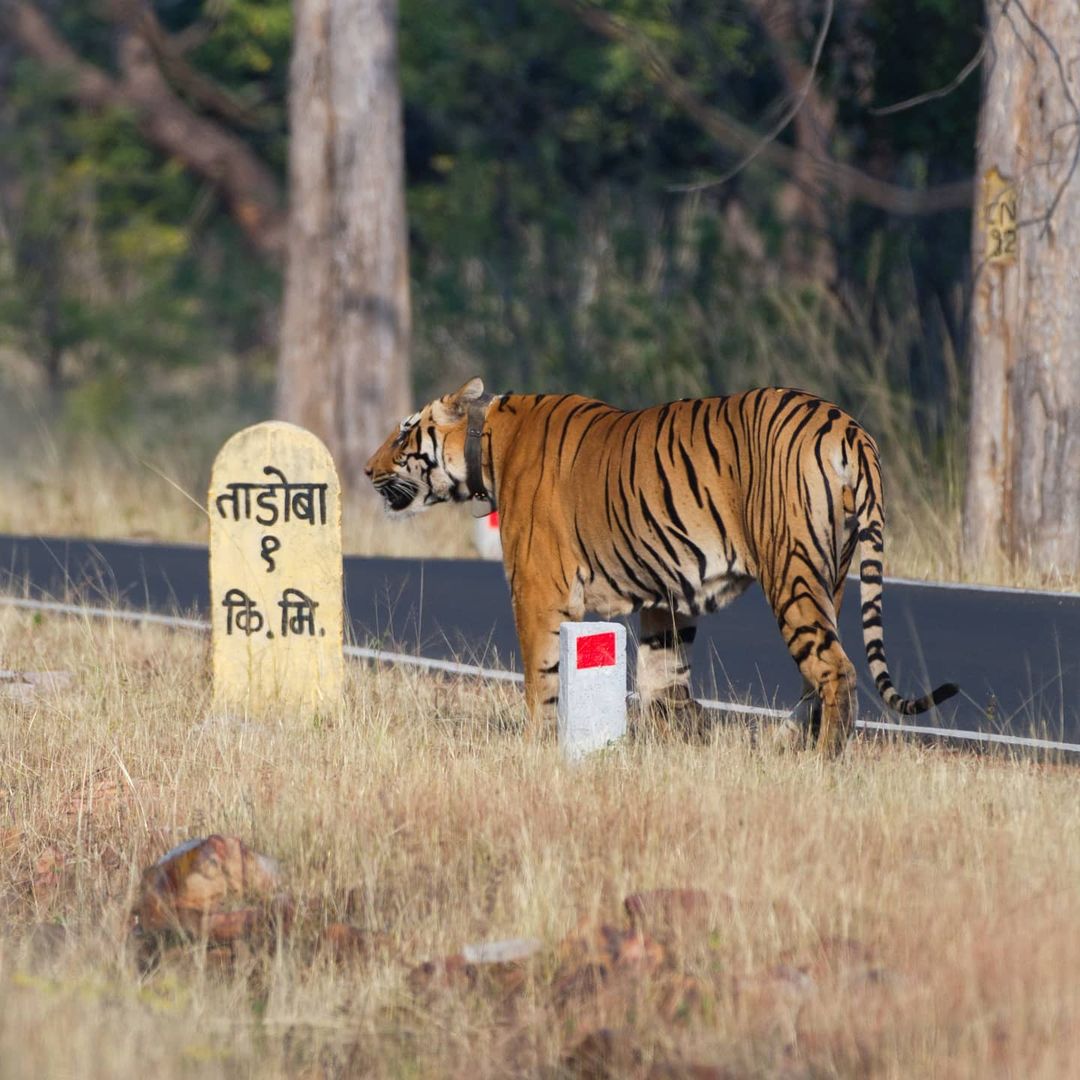 On the Road_Tadoba National Park. 2020. Instagram. Courtesy of Nihad Vajid.
On the Road_Tadoba National Park. 2020. Instagram. Courtesy of Nihad Vajid.
Undeniably, Instagram’s display preferences prioritize picture-perfect wilderness – tiger images that both conform to the tourist gaze and buffet marketable visions of wild nature. But deviations from social media’s otherwise unambivalent visual record of wild animals in pristine natural settings do exist, disclosing telltale signs of a built environment in India’s national parks. The generic photo I have in mind shows a tiger ambling down a tarmacadam road or along bush tracks made by forest department or tourist safari vehicles. Going by Instagram comments – “beautiful,” “lovely,” “spectacular,” and so forth – this is yet another example of the charismatic animal going about its day. And while these statements recoup the image for a profitable wilderness frame of reference, the visual evidence of artificial elements in a tiger habitat presents, at the same time, a view of nature enmeshed with human activity.
Related human entanglements in nature are at the forefront of Nitin D. Rai and Ajit Menon’s discussion of tourism and conservation at Biligiri Rangaswamy Temple (BRT) Tiger Reserve, Karnataka, in South India. In their article, “Putting a Price on Tiger Reserves; Creating Conservation Value or Grabbing?,” they argue against a neoliberal conservation approach which implies that “nature” can only be saved through “submission to capital.” Reiterating a widely shared viewpoint in political ecology, they discuss commercial services, delivered through the mainstream leisure industry and, to a lesser extent, ecotourism, to contend that it is “the places and the resources in these places that are valued and not the people.” From this perspective, initiatives marrying conservation to tourism are instances of when “non-capitalist spaces and resources are opened up for capital accumulation.” While those defending nature’s economic valuation point out that it is good for conservation, the relocation of communities from protected areas and expanding infrastructure for tourism in these very places is a cause of concern for others, like Rai and Menon.
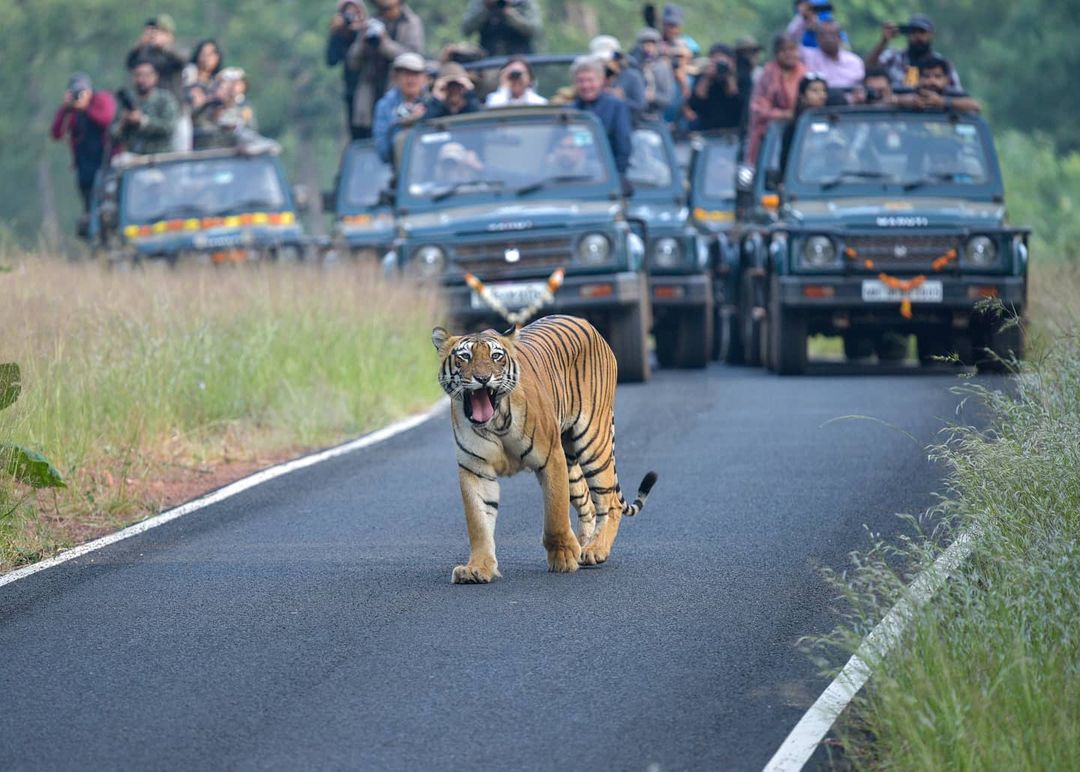 Tiger Walking Along the Road in Tadoba National Park. 2020. Instagram. Courtesy of Nihad Vajid.
Tiger Walking Along the Road in Tadoba National Park. 2020. Instagram. Courtesy of Nihad Vajid.
Monetizable social media images of apparently unperturbed wildlife and pristine nature reflect these market-based ties between tourism, conservation, and a peopleless wilderness. Admittedly, submission to capital is not the endpoint for every wild image in a digital economy. That said, some tiger images have undeniably more visibility and commercial value than others. If I go onto Instagram, finding a generic image of a tiger looking inquisitively back at the camera is as easy as finding a sunset. The platform is designed for frictionless access to easy-to-consume images. Searching for a photograph of a poaching incident generates more friction and is less instant. More difficult again is finding evidence of human-induced ecological threats that are irreducible to the single image – the impact of limited connectivity between protected areas on genetic diversity within the tiger population is not easily converted into visual representation. On the other hand, the tourist gaze is a straightforward production for any Instagram user. The image discussed earlier – a tiger striking down the road or gingerly crossing train tracks – is indubitably a direct allusion to disruptions to wildlife habitats. At the same time, given the right context, in posts tagged with a park’s location and hotel-resort or photo-tour company hashtag, for example, these tiger photos simultaneously advertise a unique set of commercially available experiences in nature.
While Instagram excels at marketing tiger tourism, it also betrays the industry’s paradox – nature’s value in a market economy depends on an apparent separation from it. What might seem even more perplexing is that the very algorithms that favor this separation are equally capable of targeting users with images that turn this self-same nature narrative on its head – a calculation based on a likelihood of capturing attention. Just as the image of the built environment adulterates commercialized notions of unspoiled landscapes, the Instagram trope of a tiger caught in the path of an open-topped jeep packed with tourists dislodges a narrative about the natural world told through images of unpeopled vistas. Here, we don’t see the commodity-image of nature in its wild state. Rather, we see a natural environment, overspilling with tourists, in the very process of being commodified into an image of wild nature.
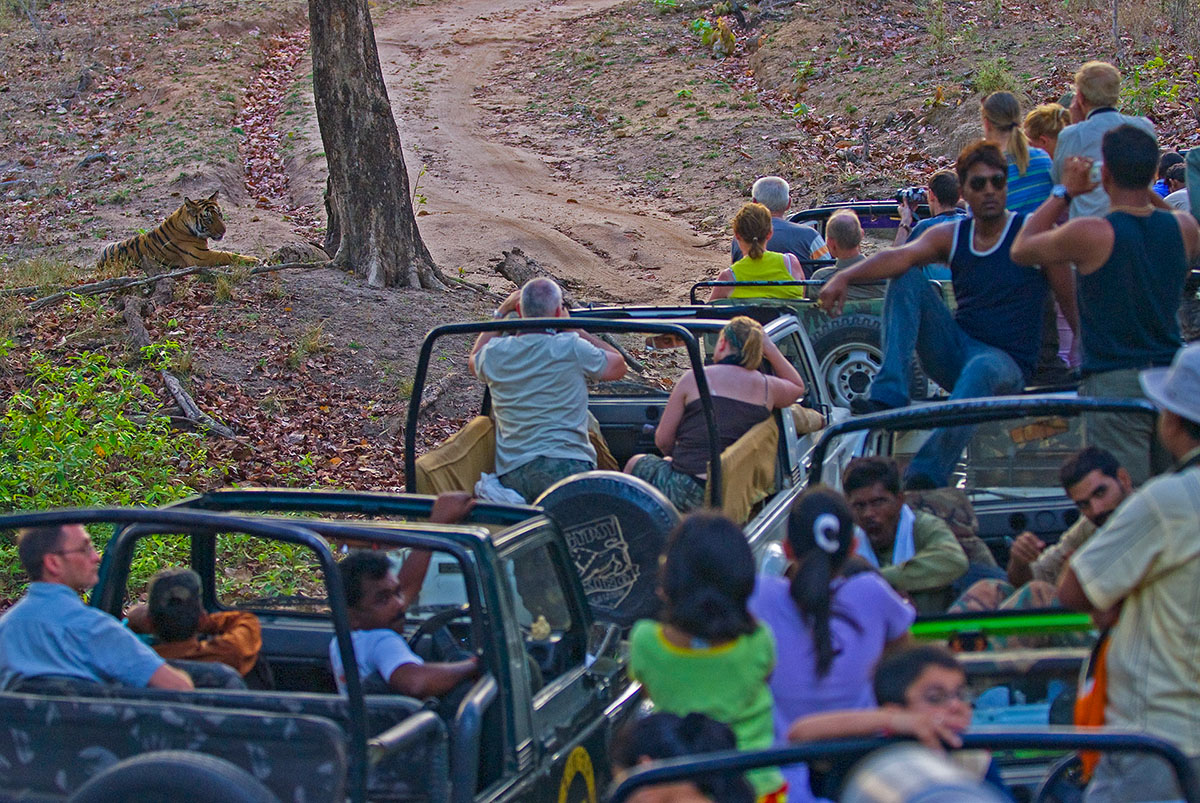 Tiger at Rest and Tourist Onlookers. 2020. Courtesy of Dhritiman Mukerjee.
Tiger at Rest and Tourist Onlookers. 2020. Courtesy of Dhritiman Mukerjee.
Usually, composition in the generic jeep-photo on Instagram directs the eye towards the tiger. Vehicles occupying its background are generally out of focus. The over-crowded jeeps are nonetheless integral to the photograph, a document of nature as visual entertainment. The image of a national park’s submission to capital replaces the picture of wilderness. In one photo, I was able to count 34 individuals looking on or snapping photographs of a tiger picking its way past a trio of stationary jeeps.
Zhayynn James posts wildlife images on Instagram, and blogs about shooting in India’s and Africa’s national parks. Wildlife images on his Instagram account (@zhayynnjamesphotography) appear to capture animals in the wild. In his blog, by contrast, he conjures a jungle teeming with people on the lookout for opportunities to photograph tigers, a situation reminiscent of what’s captured in the tourist-jeep photo. When jeeps carrying people concentrate in small areas of the forest, as so often happens, it’s a result of “alarm call ambush,” a method, he says, of using the alarm calls of deer, monkeys, and birds to predict when a tiger might emerge from the forest growth. “In some of the famous tiger reserves,” he says, “many naturalists don’t stop for anything other than a tiger. Literally. You might want to photograph a raptor or spot a fabulous photographic opportunity of a peacock dancing in golden light, but your naturalist wants to show you a tiger.” Zhayynn’s description of the “rat race to be the first vehicle to get to a tiger” illustrates the gap between undisturbed habitats depicted on Instagram and the reality behind the touristic production of wildlife photography. “Because the moment the word gets out, everyone rushes there and because the tracks are narrow, there’s yelling and shouting and gesticulating,” Zhayynn continues. While written in the spirit of helping visitors and wildlife photographers drop their tourist gaze and capture the multiplicity of Indian national parks, Zhayynn’s account also calls out a consumer mentality of getting one’s money’s worth for the live experience, and maybe even more so for its recorded double in the shape of a photograph. Taking a picture home satisfies the same urge as exiting through the gift store. By way of suggestion, Zhayynn’s post says that not everyone needs to take the same picture home with them.
Sociologist Sudha Vasan, in an ethnographic study of Ranthambore National Park in Rajasthan, and Kanha and Bandhavgarh National Parks in Madhya Pradesh, India, thinks similarly about the National Park experience, describing it as a form of “competitive consumption of commoditized nature,” pointing out the “basic contradiction” between this and “a sustainable conservation ethic.” In Vasan’s account, photography’s centrality to the consumer experience is very apparent. Recounting her experience of safari in Ranthambore National Park (RNP), she recalls that the jeep driver asked, “Has everyone finished taking photographs?” before he dissociated the jeep from the many that had surrounded this tiger.
Very often, Vasan explains, a driver who is doing his best in being attentive to his clients will keep repositioning the jeep until everyone on board has had the opportunity to frame the tiger without tourists or vehicles appearing in the shot. These, and photographs like them, are the raw ingredients for Instagram’s projection of wild nature onto India’s protected areas, a form of image commodification used in tourism, digital marketing, and personal branding. With few exceptions, neither this genre of photography nor the general flow of captions, hashtags, or comments accompanying it, conveys anything substantial about tiger conservation. Instagram’s celebration of wild nature, though, says much more about the ecosystem services nature provides. Being party to an ongoing process of financializing nature, consumer sentiment on Instagram is a guide to how the natural world is being valued, in the present, and what might be in store for its future health.
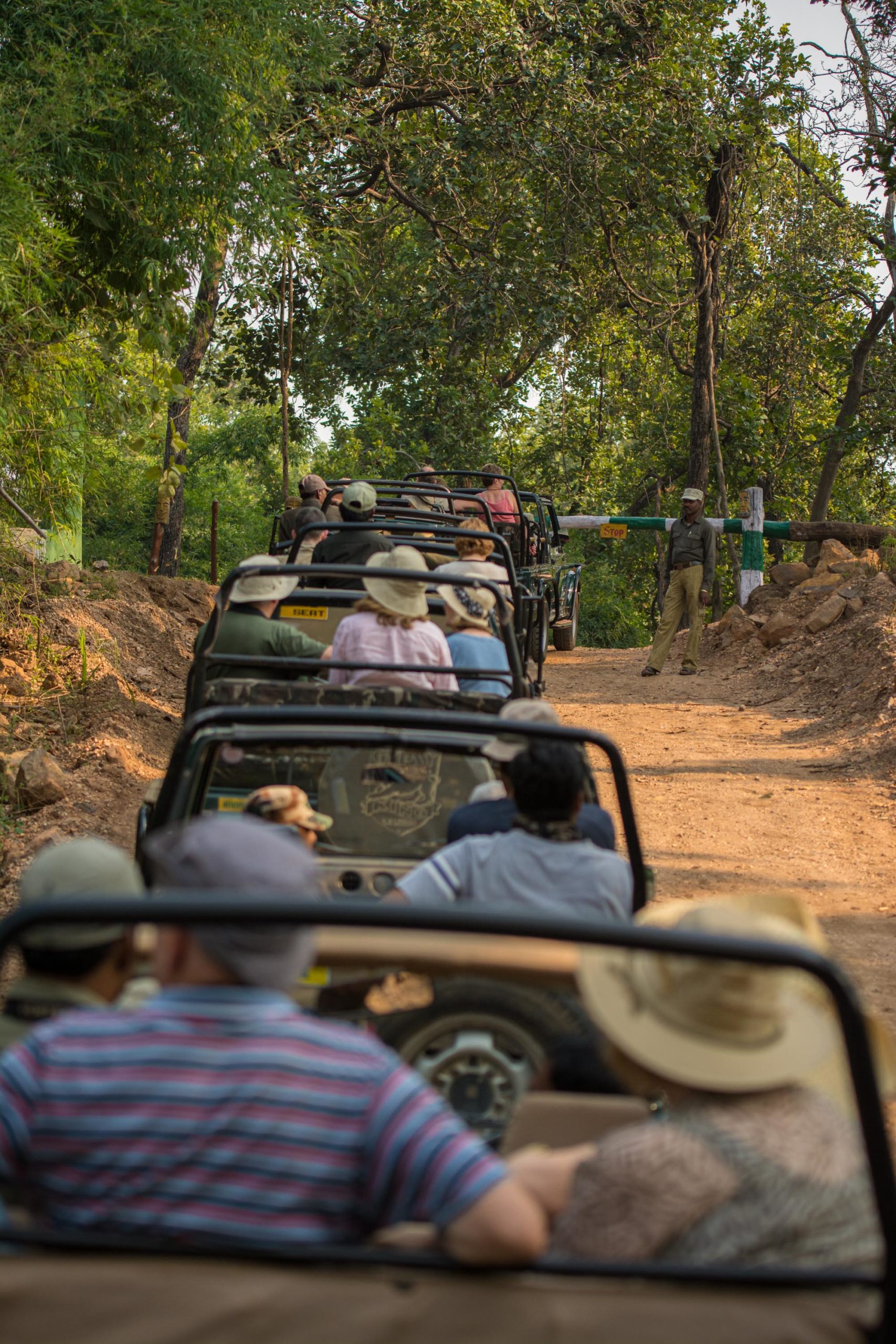 Morning Queue. Website/Blog. 2020. Courtesy of Zhayynn James.
Morning Queue. Website/Blog. 2020. Courtesy of Zhayynn James.
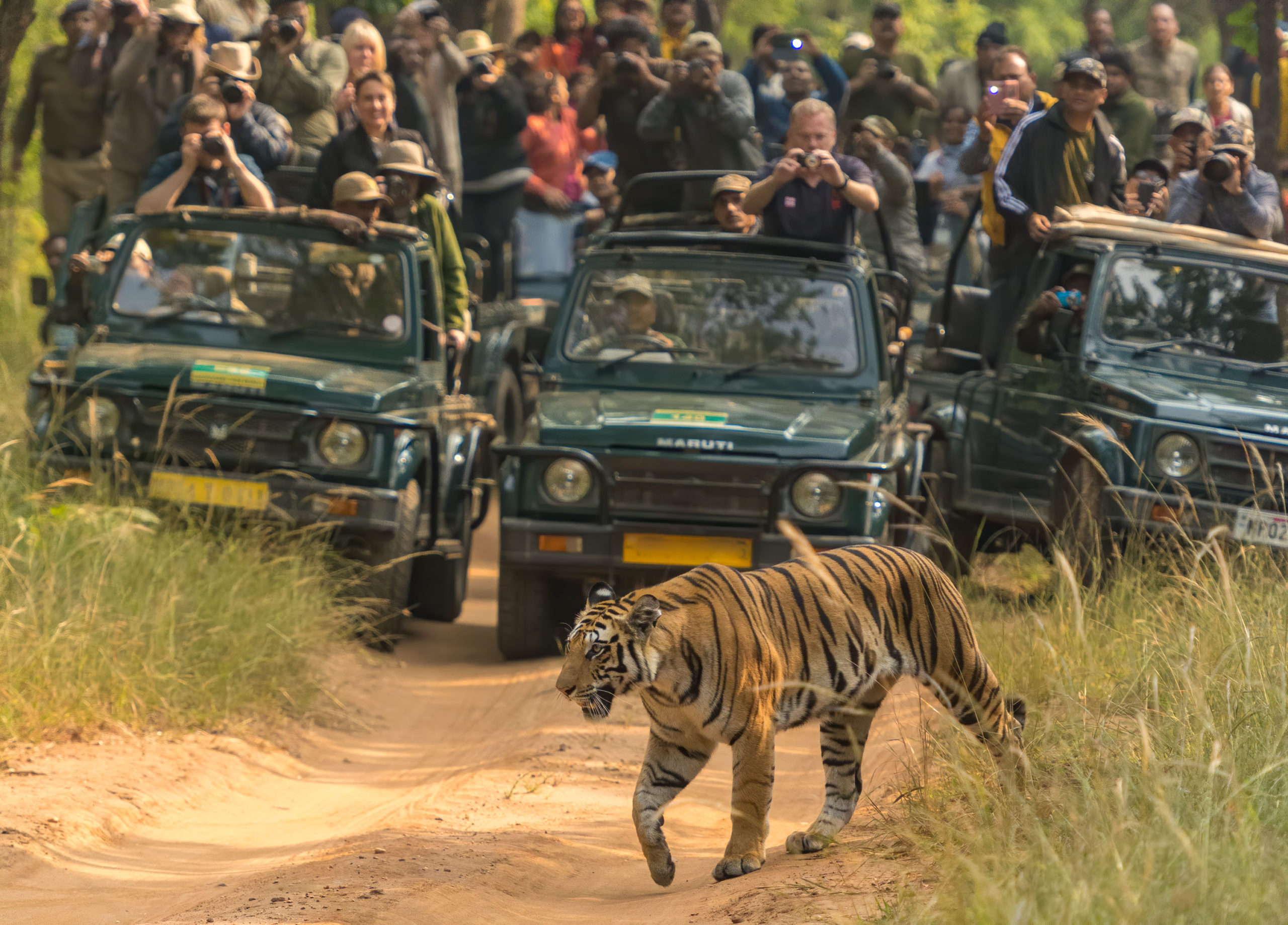 Tiger in the Path of Jeeps. Website/Blog. 2020. Courtesy of Zhayynn James.
Tiger in the Path of Jeeps. Website/Blog. 2020. Courtesy of Zhayynn James.
—–
Figure 1. Tiger Cub_Tadoba National Park. 2020. Instagram. Courtesy of Nihad Vajid.
Figure 2. On the Road_Tadoba National Park. 2020. Instagram. Courtesy of Nihad Vajid.
Figure 3. Tiger Walking Along the Road in Tadoba National Park. 2020. Instagram. Courtesy of Nihad Vajid.
Figure 4. Tiger at Rest and Tourist Onlookers. 2020. Courtesy of Dhritiman Mukerjee
Figure 5. Morning Queue. Website/Blog 2020. Courtesy of Zhayynn James.
Figure 6. Tiger in the Path of Jeeps. Website/Blog. 2020. Courtesy of Zhayynn James.
Copyright © 2022, PhotoSouthAsia. All Rights Reserved.
 Copyright © Aileen Blaney
Copyright © Aileen Blaney
Aileen Blaney is a writer and educator. She teaches film studies at Flame University, Pune. She is co-editor of Photography in India: from Archives to Contemporary Practice (Bloomsbury 2018 / Routledge 2020).
20 November